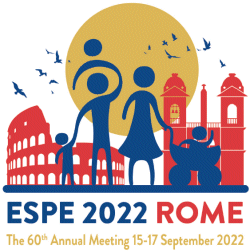
60th Annual ESPE (ESPE 2022)
Rome,
Italy
15 Sep 2022 - 17 Sep 2022
Free Communications
Bone, Growth Plate and Mineral Metabolism
hrp0095fc2.1 | Bone, Growth Plate and Mineral Metabolism | ESPE2022
Derivation of local reference intervals for serum phosphate to improve diagnosis of Hypophosphataemic rickets
Thomas Maria , Anand Binu , Park Soo-Mi , Cheung Moira , Thankamony Ajay , Oddy Sue
hrp0095fc2.2 | Bone, Growth Plate and Mineral Metabolism | ESPE2022
Final heights in 398 patients with X-linked hypophosphatemia (XLH) over the last decades in France, a surrogate marker of improved disease management. Study of a large cohort of XLH patients born between 1950 and 2006.
Berkenou Jugurtha , Boros Emese , Amouroux Cyril , Bacchetta Justine , Briot Karine , Edouard Thomas , Gueorgieva Iva , Girerd Barbara , Kamenicky Peter , Lecoq Anne-Lise , Marquant Emeline , Mignot Brigitte , Porquet Bordes Valérie , Salles Jean-Pierre , Zhukouskaya Volha , Linglart Agnès , Rothenbuhler Anya
hrp0095fc2.3 | Bone, Growth Plate and Mineral Metabolism | ESPE2022
First interim analysis of the International X-Linked Hypophosphataemia (XLH) Registry: Baseline characteristics of children treated with conventional therapy and burosumab
Boot Annemieke , Liu Jonathan , Williams Angela , Wood Sue
hrp0095fc2.4 | Bone, Growth Plate and Mineral Metabolism | ESPE2022
Patient-reported outcomes from a randomized open-label phase 3 trial comparing burosumab vs conventional therapy in children with X-linked hypophosphatemia: results from the 24-week treatment extension period
Padidela Raja , Whyte Michael P , Glorieux Francis H , Munns Craig F , Ward Leanne M , Nilsson Ola , Portale Anthony A , Simmons Jill H , Namba Noriyuki , Cheong Hae Il , Pitukcheewanont Pisit , Sochett Etienne , Högler Wolfgang , Muroya Koji , Tanaka Hiroyuki , Gottesman Gary S , Biggin Andrew , Perwad Farzana , Williams Angela , Nixon Annabel , Sun Wei , Chen Angel , Skrinar Alison , Imel Erik A
hrp0095fc2.5 | Bone, Growth Plate and Mineral Metabolism | ESPE2022
Effects of burosumab treatment on mineral homeostasis in children and adolescents with X-linked hypophosphatemia: lessons from the German XLH Registry
Ewert Annika , Rehberg Mirko , Hiort Olaf , Binder Gerhard , Schröder Carmen , Jorch Norbert , Richter-Unruh Annette , Freiberg Clemens , Peter Schlingmann Karl , Haffner Dieter , Schnabel Dirk
hrp0095fc2.6 | Bone, Growth Plate and Mineral Metabolism | ESPE2022
Pseudohypoparathyroidism Type 1A (PHP1A): Growth patterns under growth hormone therapy for short stature
Ertl Diana-Alexandra , Mantovani Giovanna , Perez de Nanclares Guiomar , Gleiss Andreas , Hanna Patrick , Marta Elli Francesca , Pereda Arrate , Rothenbuhler Anya , Audrain Christelle , Berkenou Jugurtha , Linglart Agnes



